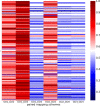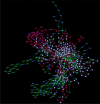Establishing a consensus for the hallmarks of cancer based on gene ontology and pathway annotations
- PMID: 33823788
- PMCID: PMC8025515
- DOI: 10.1186/s12859-021-04105-8
Establishing a consensus for the hallmarks of cancer based on gene ontology and pathway annotations
Abstract
Background: The hallmarks of cancer provide a highly cited and well-used conceptual framework for describing the processes involved in cancer cell development and tumourigenesis. However, methods for translating these high-level concepts into data-level associations between hallmarks and genes (for high throughput analysis), vary widely between studies. The examination of different strategies to associate and map cancer hallmarks reveals significant differences, but also consensus.
Results: Here we present the results of a comparative analysis of cancer hallmark mapping strategies, based on Gene Ontology and biological pathway annotation, from different studies. By analysing the semantic similarity between annotations, and the resulting gene set overlap, we identify emerging consensus knowledge. In addition, we analyse the differences between hallmark and gene set associations using Weighted Gene Co-expression Network Analysis and enrichment analysis.
Conclusions: Reaching a community-wide consensus on how to identify cancer hallmark activity from research data would enable more systematic data integration and comparison between studies. These results highlight the current state of the consensus and offer a starting point for further convergence. In addition, we show how a lack of consensus can lead to large differences in the biological interpretation of downstream analyses and discuss the challenges of annotating changing and accumulating biological data, using intermediate knowledge resources that are also changing over time.
Keywords: Co-expression network; Gene ontolog; Semantic similarity; The hallmarks of cancer.
Conflict of interest statement
The authors declare that they have no competing interests.
Figures







Similar articles
-
Evaluating the effect of annotation size on measures of semantic similarity.J Biomed Semantics. 2017 Feb 13;8(1):7. doi: 10.1186/s13326-017-0119-z. J Biomed Semantics. 2017. PMID: 28193260 Free PMC article.
-
CrowdGO: Machine learning and semantic similarity guided consensus Gene Ontology annotation.PLoS Comput Biol. 2022 May 13;18(5):e1010075. doi: 10.1371/journal.pcbi.1010075. eCollection 2022 May. PLoS Comput Biol. 2022. PMID: 35560159 Free PMC article.
-
Improving the measurement of semantic similarity by combining gene ontology and co-functional network: a random walk based approach.BMC Syst Biol. 2018 Mar 19;12(Suppl 2):18. doi: 10.1186/s12918-018-0539-0. BMC Syst Biol. 2018. PMID: 29560823 Free PMC article.
-
GO functional similarity clustering depends on similarity measure, clustering method, and annotation completeness.BMC Bioinformatics. 2019 Mar 27;20(1):155. doi: 10.1186/s12859-019-2752-2. BMC Bioinformatics. 2019. PMID: 30917779 Free PMC article.
-
Gene Ontology semantic similarity tools: survey on features and challenges for biological knowledge discovery.Brief Bioinform. 2017 Sep 1;18(5):886-901. doi: 10.1093/bib/bbw067. Brief Bioinform. 2017. PMID: 27473066
Cited by
-
Precision and efficacy of RNA-guided DNA integration in high-expressing muscle loci.Mol Ther Nucleic Acids. 2024 Sep 2;35(4):102320. doi: 10.1016/j.omtn.2024.102320. eCollection 2024 Dec 10. Mol Ther Nucleic Acids. 2024. PMID: 39398225 Free PMC article.
-
Evolvability of cancer-associated genes under APOBEC3A/B selection.iScience. 2024 Mar 6;27(4):109433. doi: 10.1016/j.isci.2024.109433. eCollection 2024 Apr 19. iScience. 2024. PMID: 38550998 Free PMC article.
-
Ontologies and Knowledge Graphs in Oncology Research.Cancers (Basel). 2022 Apr 10;14(8):1906. doi: 10.3390/cancers14081906. Cancers (Basel). 2022. PMID: 35454813 Free PMC article. Review.
-
A functional analysis of omic network embedding spaces reveals key altered functions in cancer.Bioinformatics. 2023 May 4;39(5):btad281. doi: 10.1093/bioinformatics/btad281. Bioinformatics. 2023. PMID: 37084262 Free PMC article.
-
Discovery of pathway-independent protein signatures associated with clinical outcome in human cancer cohorts.Sci Rep. 2022 Nov 11;12(1):19283. doi: 10.1038/s41598-022-23693-w. Sci Rep. 2022. PMID: 36369472 Free PMC article.
References
MeSH terms
LinkOut - more resources
Full Text Sources
Other Literature Sources
Medical

